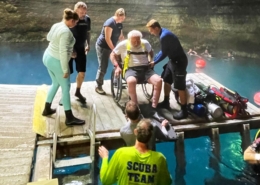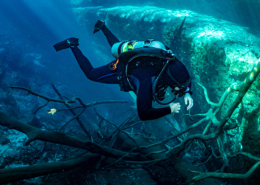Some “good” diving practices can be fatal to coral reefs
by Autumn Blum, founder and formulator, Stream2Sea:
As divers, we focus on good diving practices: we take care of our equipment, we practice good buoyancy control, we continue our training, and more. On the surface, we ensure we have good personal practices while we are exposed to the sun; we know we need to use sunscreen, and many believe the higher the SPF, the better.
That last item, however, could be fatal to coral and other chemically sensitive critters.
Common ingredients
It’s practically impossible to formulate a sunscreen with an SPF of above 30 (which already blocks nearly 97 percent of the sun’s most damaging rays) without using chemical ingredients. One of the most common ingredients, benzophenone-3, also known as oxybenzone, kills coral at concentrations as low as 62 parts per trillion – about a drop of water in six and a half Olympic-sized swimming pools.
While the studies were conducted in a laboratory setting, far higher concentrations of oxybenzone were actually measured near coral reefs in Hawaii and the U.S. Virgin Islands. Concentrations are highest in the most popular diving areas, with one spot in the Virgin Islands measured at 1.4 parts per million, more than 12 times higher than the concentrations necessary to damage vulnerable coral larva. (NOAA estimates that up to 14,000 tons of sunscreens wash off divers every year.)
Not just the coral reefs
It’s not just the coral reefs; many of these chemical ingredients bio-accumulate in the environment and in our bodies. A 2008 study from the U.S. Centers for Disease Control indicates that 97% of Americans have at least some oxybenzone in their blood – and linked it to allergies, hormone disruption, cell damage and low birth weight for baby girls who are exposed during pregnancy.
And it’s not just oxybenzone. Parabens and formaldehyde-releasing preservatives like DMDM hydantoin have demonstrated estrogenic activity and clear aquatic toxicity. Other ingredients like cylcopentasiloxane and cyclomethicone are silicone-based ingredients often used in skin and hair care products that have been shown to be toxic and to bio-accumulate in aquatic organisms.
Even ZinClear, a very popular ingredient in mineral-based sunscreens, has a direct warning for aquatic toxicity on its data sheet, for formulators who care enough to research its impact on ecosystems.
It’s up to us
We count on our government to regulate sunscreen and personal care products for safety – but the truth of the matter is that since the FDA began regulating cosmetics in 1938, a whopping eight ingredients have been banned, including the highly celebrated ban on microbeads. Compare that to more than 11,000 ingredients that are not allowed in Europe – it’s clearly up to us to understand the long-term and wide-ranging impacts of the products we choose to put on our bodies and in our waters.
It may start out as a drop in a bucket, but together we can do better!
Autumn Blum is an award-winning cosmetic chemist and the founder of Stream2Sea, a company setting a new standard for EcoConscious sunscreen and skincare with the most comprehensive series of aquatic toxicity tests in the world. Stream2Sea products are currently available online at www.Stream2Sea.com or ask for them at your favorite health food store, dive shop or outdoor retailer. Friend us on Facebook, call (866) 960-9513 or email us for a biodegradable “Ingredients to Avoid Card” that highlights the worst offenders in an easy-to-use reference sheet at hello@stream2sea.com.










השאירו תגובה
רוצה להצטרף לדיון?תרגישו חופשי לתרום!